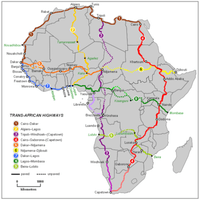Tripoli–Cape Town Highway
The Tripoli–Cape Town Highway is Trans-African Highway 3 in the transcontinental road network being developed by the United Nations Economic Commission for Africa (UNECA), the African Development Bank (AfDB), and the African Union. The route has a length of 10,808 km (6,716 mi) and has the longest missing links and requires the most new road construction.
| |
|---|---|
| Highway system | |
| Trans-African Highway network |
South Africa was not originally included in the route which was first planned in the Apartheid era, but it is now recognized that it would continue to Cape Town. It may still be referred to in documents as the Tripoli-Windhoek Highway because of this fact.
It is meant to be the second link between North and Southern Africa, with the Cairo-Cape Town Highway being the other route, passing through East Africa.
Route
The route passes through Libya, Chad, Cameroon, Central African Republic (CAR), Republic of the Congo (ROC), the western tip of the Democratic Republic of the Congo (DRC), Angola, Namibia and South Africa. Only national paved roads in Libya, Cameroon, Angola, Namibia and South Africa can be used to any extent. Currently only desert tracks run from southern Libya to the vicinity of Ndjamena, a distance of more than 2000 km, and no track of any kind exists between Salo, CAR and Ouésso, ROC.
Northern section
The Tripoli–Cape Town Highway is not a high priority in its northern section across the Sahara between Tripoli and Ndjamena, for which the Trans-Sahara Highway further west would probably find more usage and which provides an alternative north-south route. Libya is said to be more interested in road links to Niger which would connect with the Trans-Sahara Highway. Coupled with lawlessness and the potential for instability in the Libya-Chad border regions, the northern section is likely to be the last to be developed and may be a couple of decades away from completion.
Central section
It is the central section between northern Angola and Cameroon which is most needed because it would provide the first paved link between the West African and Southern African regions, and it would do the most to stimulate trade which currently has to go by air or sea. The central section is however a 'missing link', and the planned alignment between CAR and ROC would pass through some of the most remote and difficult terrain and rainforests of the Sangha River basin. This alignment has the potential for an enormous environmental impact on relatively untouched forest within a number of nature reserves.
An alternative alignment for the road has been proposed between Yaoundé, Cameroon and Brazzaville, ROC, which would do more to facilitate transport between the south and west of the continent, and which would probably have less of an environmental impact. It would run via Lambaréné (Gabon), and Dolisie (ROC). From the south, traffic going to West Africa would branch off in Yaoundé onto the western section of the Lagos-Mombasa Highway, while traffic going east and north would share the paved road from Yaoundé to Garoua-Boulai on the Cameroon-CAR border. As well as being shorter for traffic between south and west, this alternative alignment has other advantages: it already carries a little international traffic, it runs through more populated and economically active areas, it adds Gabon (and its capital, Libreville, via a spur) to the network, and it passes very close to Equatorial Guinea (Rio Muni) and the Atlantic ports of Douala and Pointe-Noire. Furthermore, a greater proportion of this section is paved, and those sections which are gravel roads or earth tracks are important as national roads and so are higher priorities for paving.
Between Dolisié and Matadi an alternative mainly paved route is also available through Pointe-Noire and Cabinda, crossing the Congo River at the Matadi Bridge, instead of by ferry between Brazzaville and Kinshasa.
Southern section
The southern section between DRC and Cape Town on the other hand is an important regional road in the Southern African Development Community (SADC) context, and it already links to SADC highway corridors such as the Trans–Caprivi Highway and the trade corridor from Walvis Bay to Maputo. Paving of existing roads is required in northern Angola but from Ngage through Angola, Namibia and South Africa to Cape Town, the route is all paved and is in a fair to good condition.
See also
- Trans-African Highway network
- Lagos-Mombasa Highway
References
- African Development Bank/United Nations Economic Commission For Africa: "Review of the Implementation Status of the Trans African Highways and the Missing Links: Volume 2: Description of Corridors". August 14, 2003. Retrieved 14 July 2007.
- Michelin Motoring and Tourist Map: "Africa North and West". Michelin Travel Publications, Paris, 2000.

